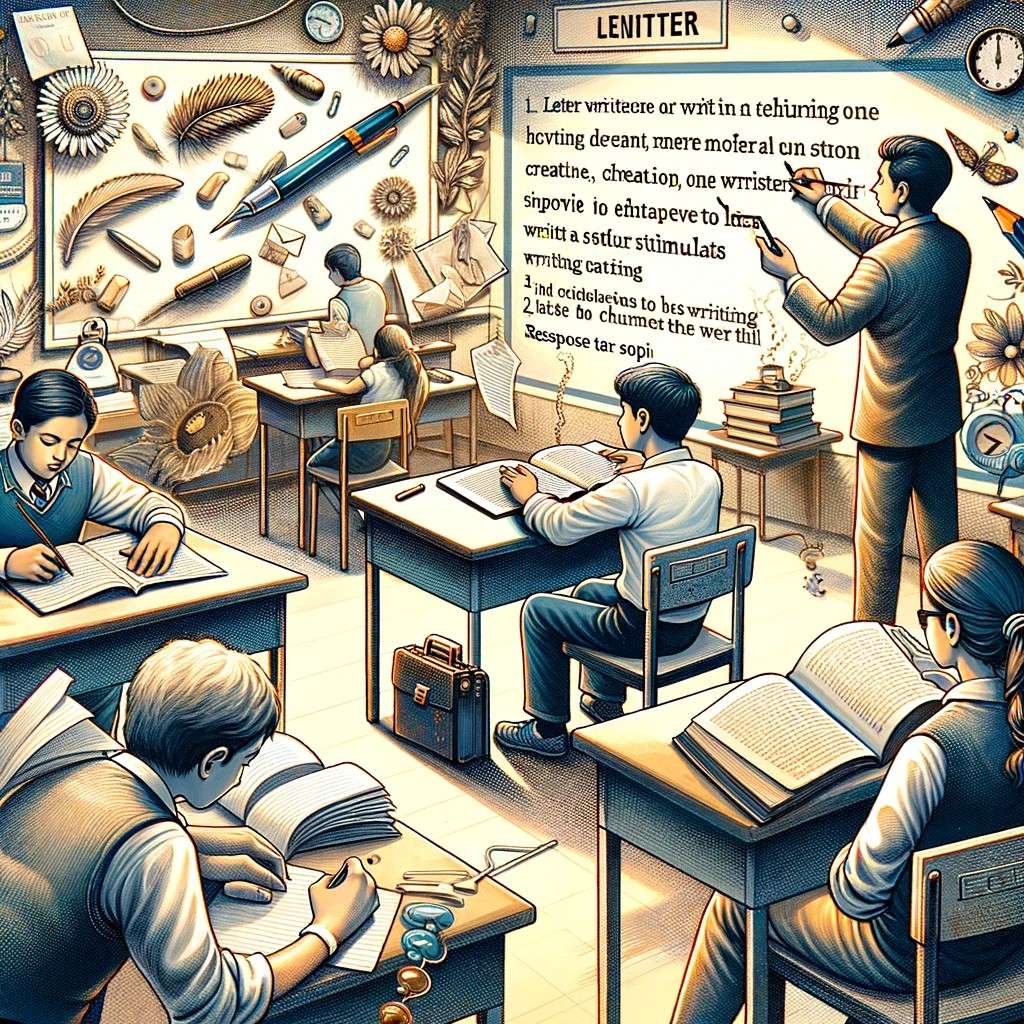
NCERT Class 10 English Chapter 2: Mastering Letter Writing, Short Stories, and Stimulus-Based Tasks – By Shala Saral

Chapter 2 ‘Writing’ section in the NCERT Class 10th English textbook, we’ll break it down into the specific parts you mentioned:
1. Letter Writing
a. Personal
b. Official
c. Email
i. To family, friends, relatives
ii. To Government officials, the editor of a newspaper or magazine, Headmaster/Principal, teachers, etc.
2. Writing a Short Story
a. Develop an outline for a short story
b. Crafting the story in about 80 words based on the given outline
3. Short Writing Task
a. Based on a verbal or visual stimulus (e.g., picture, chart, table)
b. Writing a piece in about 80 words with an internal choice
1. Letter Writing
Letter writing is a fundamental skill in English, offering a way to communicate in a structured and formal manner. It’s divided into different categories based on the recipient and purpose of the letter.
a. Personal Letters
Personal letters are informal and shared with people we know personally, like family and friends. The tone is relaxed and conversational, and the format is flexible. Key components include:
- Date and Address: Start with your address and the date.
- Salutation: Use informal greetings like ‘Dear [Name],’ or ‘Hello [Name],’.
- Body: Share your news, ask about the recipient’s well-being, and express your thoughts and feelings. This can be multiple paragraphs.
- Closing: Use informal closings such as ‘Best Wishes,’ ‘Lots of Love,’ etc.
- Signature: End with your first name or a nickname.
b. Official Letters
Official letters are formal and sent to professionals, companies, or institutions. They follow a strict format with a formal tone. Components include:
- Sender’s Address and Date: Placed at the top.
- Receiver’s Address: Below the sender’s address.
- Subject Line: A concise line summarizing the letter’s purpose.
- Salutation: Formal greetings like ‘Dear [Title and Last Name],’ or ‘To Whom It May Concern,’
- Body: Clearly state the purpose of your letter in the first paragraph. Follow with supporting details and a polite request or conclusion.
- Closing: Use formal closings like ‘Yours Sincerely,’ or ‘Yours Faithfully,’
- Signature and Name: Sign and type your full name.
c. Emails
Emails have become a standard form of communication, blending formal and informal styles depending on the recipient.
i. To Family, Friends, Relatives
- Subject Line: Brief and indicative of the email’s content.
- Salutation: Informal, like ‘Hi [Name],’ or just the name.
- Body: Similar to a personal letter but usually shorter and more direct.
- Closing: Informal, like ‘Best,’ ‘Cheers,’ or ‘Love,’
- Signature: Your first name or a casual sign-off.
ii. To Government Officials, Editors, Headmasters, Teachers
- Subject Line: Clear, precise, and formal.
- Salutation: Formal, using titles and last names.
- Body: Begin with the reason for your email. Be concise, respectful, and clear. Stick to the point and maintain a formal tone.
- Closing: Use formal phrases like ‘Respectfully,’ or ‘Yours Sincerely,’
- Signature: Include your full name and, if relevant, your position or affiliation.
Conclusion
Effective letter writing is a key skill in both personal and professional contexts. Understanding the differences in tone, format, and style based on the recipient and purpose is crucial for clear and effective communication. Students are encouraged to practice these skills, as they are valuable in a wide range of scenarios throughout life.
Certainly, let’s provide examples for each type of letter and email to illustrate how they are structured and written.
a. Personal Letter Example
[Your Address] [City, State, Zip] [Date]
Dear [Friend’s Name],
How have you been? It feels like ages since we last caught up. I hope everything is going well with you and your family.
I wanted to share some exciting news with you. Last week, I started a new job at [Company Name]. It’s quite challenging, but I’m really enjoying it. The team is great, and I’m learning a lot.
How are things on your end? How’s your photography going? I remember you mentioning a potential exhibition. I’d love to hear more about it.
Looking forward to catching up soon. Maybe we can plan a get-together sometime next month?
Take care and say hello to everyone from me.
Warm regards, [Your First Name]
b. Official Letter Example
[Your Name] [Your Address] [City, State, Zip] [Date]
[Recipient’s Name] [Recipient’s Position] [Company/Organization Name] [Address] [City, State, Zip]
Subject: Application for the Position of [Job Title]
Dear [Recipient’s Name],
I am writing to apply for the position of [Job Title] at [Company/Organization Name], as advertised on [where you found the job listing]. With my background in [your field of expertise] and extensive experience in [relevant experience], I am confident in my ability to contribute effectively to your team.
In my previous role at [Previous Company], I successfully [mention a key achievement or responsibility that is relevant to the new job]. This experience has honed my skills in [mention relevant skills], making me well-suited for the role of [Job Title].
I am particularly drawn to this opportunity at [Company/Organization Name] because [mention what you find appealing about the company or role].
Enclosed is my resume, which provides further details about my qualifications. I am looking forward to the opportunity to discuss my application with you in more detail.
Thank you for considering my application. I am eager to bring my expertise to [Company/Organization Name] and contribute to your team’s success.
Yours sincerely,
[Your Name]
c. Email Examples
i. Email to Family
Subject: Exciting Family News!
Hi Mom and Dad,
I hope this email finds you both well. I have some fantastic news to share – I’ve been accepted into my first-choice university! I’m thrilled and wanted you two to be the first to know.
I’ll call over the weekend to chat more about it. Can’t wait to celebrate this with you!
Love, [Your Name]
ii. Email to a Government Official
Subject: Inquiry Regarding Community Park Renovations
Dear Councilor [Last Name],
I am writing as a resident of [Your Neighborhood] to inquire about the progress of the renovations at [Local Park Name]. As you are aware, this park is a vital community space, and its closure has significantly impacted the neighborhood.
Could you provide an update on the renovation schedule and any potential delays? Many residents, including myself, are eager to see the park reopen.
Thank you for your attention to this matter. We appreciate your efforts in improving our community facilities.
Respectfully, [Your Full Name] [Your Address]
2. Writing a Short Story
Writing a short story, especially within a limited word count like 80 words, is a unique challenge. It requires creativity, conciseness, and a clear understanding of the story’s structure. Below, I’ll guide you through developing a story outline and then crafting a short story based on that outline.
a. Developing an Outline for a Short Story
An effective outline for a short story should include the following elements:
- Setting: Where and when the story takes place.
- Characters: A brief description of the main characters.
- Conflict: The central problem or challenge the characters face.
- Resolution: How the conflict is resolved.
Let’s create an example outline:
- Setting: A small coastal town, present day.
- Characters:
- Main Character: Alex, a young aspiring artist.
- Supporting Character: Mrs. Parker, a wise old woman who used to be a famous painter.
- Conflict: Alex is struggling to find inspiration for an important art competition.
- Resolution: Inspired by a conversation with Mrs. Parker, Alex discovers beauty in everyday life and creates a winning piece.
b. Crafting the Short Story (Approximately 80 words)
Based on the above outline, here’s an example of a short story:
“In the sleepy coastal town of Seabreeze, Alex sat, canvas blank, feeling uninspired. The art competition was days away, yet ideas eluded him. Wandering the streets, he encountered Mrs. Parker, once a renowned painter. Her words, ‘True art reflects the beauty in the mundane,’ sparked a realization. Alex rushed back, his brush dancing across the canvas, capturing the essence of Seabreeze – the sun-kissed waves, the laughter of children, the tranquility. His painting, ‘Everyday Splendor,’ won first place.”
Conclusion
Writing a short story in 80 words is about distilling a narrative to its essence. Start with a clear outline, establish a setting, introduce compelling characters, present a conflict, and aim for a satisfying resolution. This exercise not only hones your creative writing skills but also teaches you the art of being concise and impactful with words. Practice with different themes and settings to refine your storytelling abilities.

3. Short Writing Task
For Class 10th students, the short writing task focuses on developing concise and expressive writing skills. This task involves creating a brief piece of writing, typically around 80 words, based on a prompt which can be either verbal (like a quote or a statement) or visual (like a picture, chart, or table). Let’s dive into how students can approach this task effectively.
a. Understanding the Stimulus
Whether the stimulus is verbal or visual, the first step is to understand and interpret it. Ask yourself:
- What is the main theme or subject of the stimulus?
- What feelings or thoughts does it evoke?
- How can you connect it to a broader context or your own experiences?
b. Writing the Piece
Once you’ve interpreted the stimulus, start drafting your piece. Here are some tips:
- Be Concise: With only 80 words, every word must count. Aim for clarity and brevity.
- Have a Clear Focus: Stick to a single idea or theme.
- Show, Don’t Tell: Use vivid language to create images or convey emotions.
- End with Impact: Conclude with a thought-provoking or insightful comment.
Examples
Let’s consider two examples, one based on a verbal stimulus and the other on a visual stimulus.
Verbal Stimulus: “The only constant in life is change.” – Heraclitus
Response:
Change, like a relentless tide, shapes our lives. Seasons shift, friends come and go, and we evolve. Heraclitus’s words echo in my mind as I stand at the crossroads of adolescence and adulthood. Embracing change, I step forward, ready to write the next chapter of my life.
Visual Stimulus:

Response:
The city at night buzzes with electric life. Lights twinkle like stars, mirroring the sky. In its busy streets, I find a symphony of aspirations. Each light, a story; every face, a dream. Amidst the chaos, there is a rhythm, a heartbeat that pulses with endless possibilities.
Conclusion
For Class 10th NCERT students, these short writing tasks are not just exercises in writing but opportunities to express creativity and thoughts succinctly. Practice with different stimuli to enhance your ability to think and write quickly and effectively. Remember, these tasks are as much about the journey of thought as they are about the final written piece.